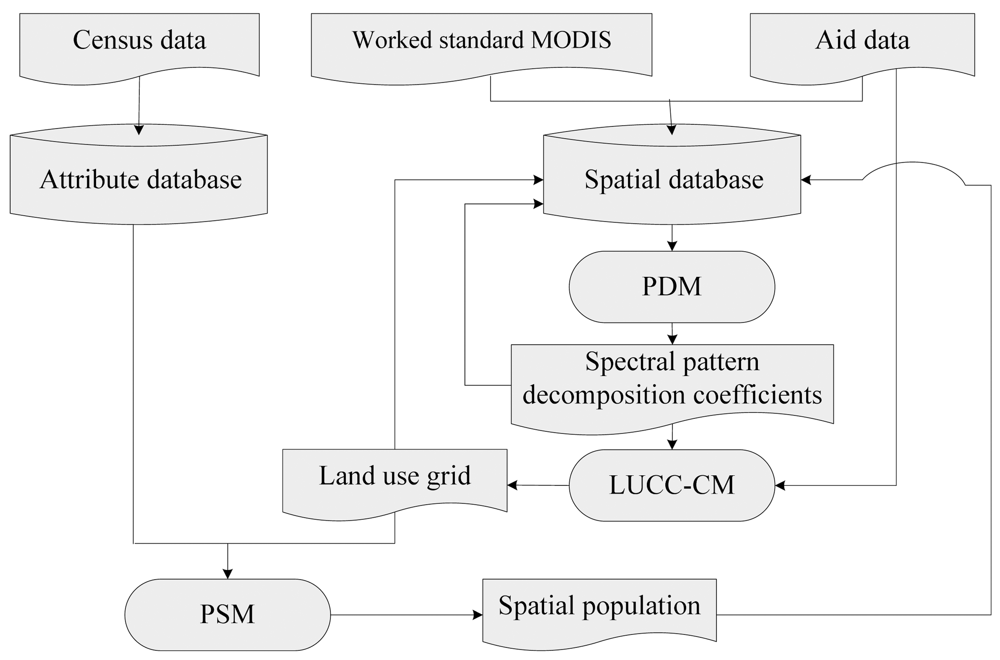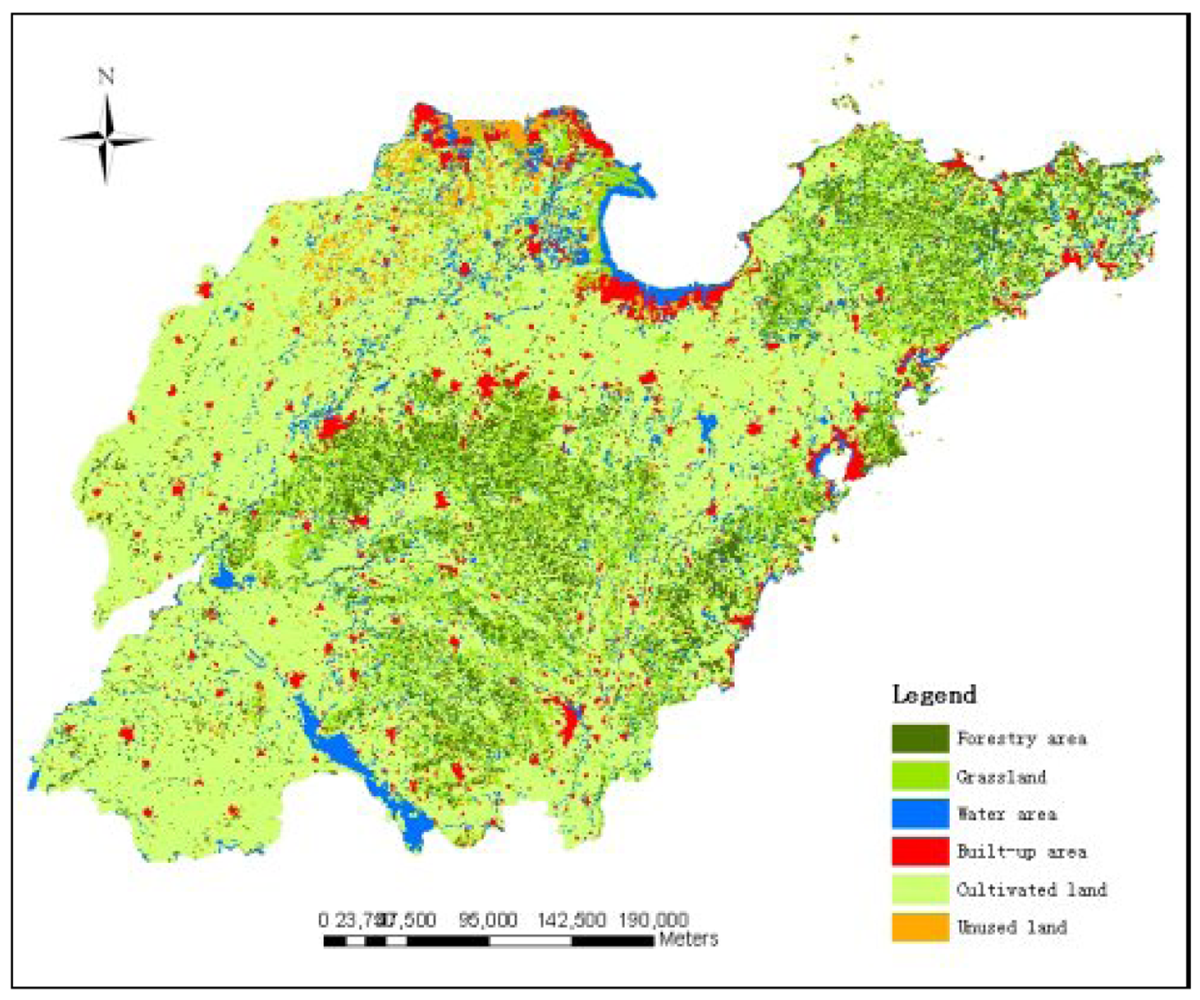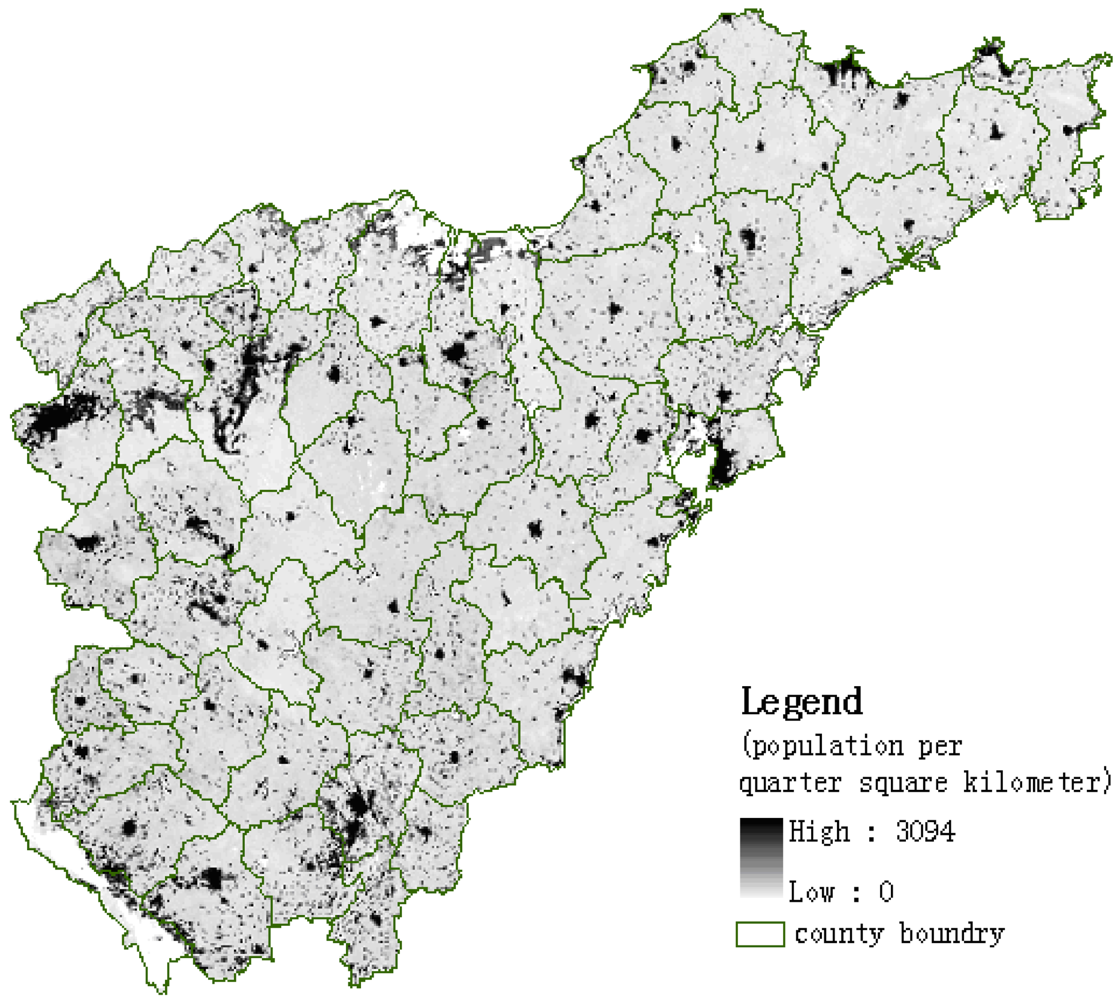An Updating System for the Gridded Population Database of China Based on Remote Sensing, GIS and Spatial Database Technologies
Abstract
:1. Introduction
2. Data and Methodology
2.1. Data Sources
2.2. Methodology for Land-use/Land-cover (LULC) Data Updating
(1) Pattern Decomposition Method (PDM)
(2) LULC-Conversion Model (LULC-CM)
2.3. Method of Population Spatialization
(1) Regionalization of Spatial Population Distribution
(2) Population Spatialization Model (PSM)
3. SPUS System Design and Development
3.1. Flowchart for Data Processing
3.2. System Function Development
(1) Management Module of Spatial Data
(2) Management Module of Statistical Data
(3) Spectral Pattern Decomposition Module
(4) LULC-CM Module
(5) Population Data Spatialization Module
- Data display. The main interface that can add and display spatial data and provide functions of querying, panning, zooming in, zooming out, selecting and saving.
- Model processing. To create spatial population grids based on PSM.
- Results verification. To adjust the primary results according to total population control within county level units to generate the final result of gridded spatial population dataset.
(6) Spatial Analysis Module
4. Results
5. Conclusions
Acknowledgments
References
- Goldewijk, K.K. Three centuries of global population growth: A spatial referenced population (density) database for 1700–2000. Popul. Environ. 2005, 26, 343–367. [Google Scholar]
- Hales, S.; de Wet, N.; Maindonald, J.; Woodward, A. Potential effect of population and climate changes on global distribution of dengue fever: An empirical model. Lancet 2002, 360, 830–834. [Google Scholar]
- Hay, S.I.; Guerra, C.A.; Tatem, A.J.; Noor, A.M.; Snow, R.W. The global distribution and population at risk of malaria: Past, present, and future. Lancet Infect. Dis. 2004, 4, 327–336. [Google Scholar]
- Lutz, W. The future population of the world. What can we assume today? Revised and Updated Edition; Earthscan Publications: London, 1996. [Google Scholar]
- Small, C.; Gornitz, V.; Cohen, J.E. Coastal hazards and the global distribution of human population. Environ. Geosci. 2000, 7, 3–12. [Google Scholar]
- Sutton, P. Modeling population density with nighttime satellite imagery and GIS. Compu. Environ. Urban Syst. 2007, 21, 227–244. [Google Scholar]
- Caruthers, A.W. Mapping the population census of Scotland. Cartogr. J. 1985, 22, 83–87. [Google Scholar]
- Tobler, W.; Deichmann, U.; Gottsegen, J.; Maloy, K. The global demography project. In Technical Report TR-95-6; National Center for Geographic Information and Analysis, Department of Geography,University of California: Santa Barabara, 1995. [Google Scholar]
- Tobler, W.; Deichmann, U.; Gottsegen, J.; Maloy, K. World population in a grid of spherical quadrilaterals. Int. J. Popul. Geogr. 1997, 3, 203–225. [Google Scholar]
- Balk, D.; Brickman, M.; Anderson, B.; Pozzi, F.; Yetman, G. Estimates of future global population distribution to 2015. CIESIN, Columbia University: Palisades, NY, 2005. Available online: http://sedac.ciesin.columbia.edu/gpw/documentation.jsp#.
- Balk, D.; Pozzi, F.; Yetman, G.; Deichmann, U.; Nelson, A. The distribution of people and the dimension of place: Methodologies to improve the global estimation of urban extents. Draft version. Palisades, Columbia University: New York, NY, CIESIN, 2004. Available online: http://beta.sedac.ciesin.columbia.edu/gpw/documentation.jsp.
- Balk, D.; Yetman, G. The global distribution of population: Evaluating the gains in resolution refinement, documentation for GPW v3. Palisades, Columbia University: NY, CIESIN, 2004. Available online: http://beta.sedac.ciesin.columbia.edu/gpw/documentation.jsp.
- CIESIN (Center for International Earth Science Information Network), Columbia University; Centro Internacional de Agricultura Tropical (CIAT). Gridded population of the world version 3 (GPWv3): Population grids. Socioeconomic Data and Applications Center (SEDAC), Columbia University: Palisades, NY, 2005. Available online: http://sedac.ciesin.columbia.edu/gpw.
- Salvatore, M.; Pozzi, F.; Ataman, E.; Huddleston, B.; Bloise, M. Mapping global urban and rural population distributions; FAO: Rome, 2005. [Google Scholar]
- Balk, D.L.; Deichmann, U.; Yetman, G.; Pozzi, F.; Hay, S.I. Determining global population distribution: methods, applications and data. Adv. Parasit. 2006, 62, 119–156. [Google Scholar]
- Dobson, J.E.; Bright, E.A.; Coleman, P.R.; Durfee, R.C.; Worley, B.A. LandScan: A global population database for estimating populations at risk. Photogramm. Eng. Rem. Sens. 2000, 66, 849–857. [Google Scholar]
- Bhaduri, B.; Bright, E.; Coleman, P.; Dobson, J. LandScan: Locating people is what matters. Geoinformatics 2002, 5, 34–37. [Google Scholar]
- Yang, X.; Jiang, D.; Wang, N.; Liu, H. Method of Pixelizing Population Data. J. Geogr. Sci. 2002, 57 Supp, 70–75. [Google Scholar]
- Yang, X.; Wang, N.; Jiang, D.; Xiong, L.; Liu, H. Regionalization of population distribution based on spatial analysis. J. Geogr. Sci. 2002, 57 Supp, 76–81. [Google Scholar]
- Muramatsu, K.; Furumi, A.; Fujiwara, N. Pattern decomposition method in the albedo space for Landsat TM and MSS data analysis. Int. J. Remote Sens. 2000, 21, 99–119. [Google Scholar]
- Zhang, X.; Yang, X. Spectral pattern extract and related analysis based on Landsat 7 ETM+ images – Taking land cover in Miyun district of Beijing as a case. Geo. Inf. Sci. 2005, 7, 107–110. [Google Scholar]
- Hu, H. On population distribution of China; China Science Press: Beijing, China, 1983; p. 518. (in Chinese) [Google Scholar]
- Mennis, J.; Hultgren, T. Intelligent dasymetric mapping and its application to areal interpolation. Cartogr. Geogr. Inf. Sci. 2006, 33, 179–194. [Google Scholar]





| Data type | Time | Data sources | Scale or resolution |
|---|---|---|---|
| Census data | 1995∼2002 | State Bureau of Statistics of China | County level |
| MODIS L1B | 2002 | EOS website | 500 m |
| Statistical social and economic data | 2000 | Chinese Statistic Yearbooks | County level |
| Land use | 2000 | Resources and Environmental Scientific Data Center (RESDC), Chinese Academy of Sciences (CAS) | 1: 100,000 |
| DEM data | 2000 | State Bureau of Surveying and Mapping of China | 1: 250,000 |
| Boundary of counties | 2000 | RESDC | 1: 100,000 |
| Residential map | 2000 | State Bureau of Surveying and Mapping of China | 1: 250,000 |
| Statistic population of Yishui County, Shandong Province | 2002 | Statistic Yearbook of Yishui County | Township level |
| Band1 | Band2 | Band3 | Band4 | Band5 | Band6 | Band7 | |
|---|---|---|---|---|---|---|---|
| Water pattern Pw | 0.30589 | 0.23765 | 0.17209 | 0.11474 | 0.07647 | 0.05731 | 0.03585 |
| Vegetation pattern Pv | 0.08983 | 0.08372 | 0.06711 | 0.24593 | 0.24880 | 0.17251 | 0.09210 |
| Soil pattern Ps | 0.09182 | 0.08918 | 0.09733 | 0.17880 | 0.20528 | 0.19181 | 0.14579 |
| No. | Town name | Population (statistical) | Population (gridded) | Error | Relative error (%) |
|---|---|---|---|---|---|
| 1 | Quan Li | 37,256 | 46,805 | 9,550 | 25.63 |
| 2 | Sha Gou | 68,566 | 83,018 | 14,451 | 21.08 |
| 3 | Ma Zhan | 67,456 | 54,435 | -13,021 | -19.30 |
| 4 | Fu Guanzhuang | 46,085 | 57,410 | 11,325 | 24.57 |
| 5 | Yang Zhuang | 63,408 | 61,389 | -2,019 | -3.18 |
| 6 | Zhe Ge | 75,325 | 90,975 | 15,650 | 20.78 |
| 7 | Gao Qiao | 60,146 | 46,109 | -14,037 | -23.34 |
| 8 | Quan Zhuang | 34,293 | 34,118 | -175 | -0.51 |
| 9 | Yi Shui | 175,136 | 152,313 | -22,823 | -13.03 |
| 10 | Dao Tuo | 36,831 | 36,831 | -2,529 | -6.43 |
| 11 | Gao Zhuang | 51,507 | 50,914 | -593 | -1.15 |
| 12 | Long Jiaquan | 61,231 | 47,691 | -13,540 | -22.11 |
| 13 | Chui Jiayu | 33,380 | 39,101 | 5,721 | 17.14 |
| 14 | Huang Shanpu | 50,252 | 37,842 | -12,410 | -24.70 |
| 15 | Xu Jiahu | 81,431 | 76,713 | -4,718 | -5.79 |
| 16 | Yuan Dongtou | 29,191 | 36,185 | 6,994 | 23.96 |
| 17 | Si Shilipu | 66,312 | 61,245 | -5,067 | -7.64 |
| 18 | Yao Dianzi | 44,766 | 40,533 | -4,233 | -3.52 |
| 19 | Xia Wei | 54,898 | 52,967 | -1,931 | -2.93 |
© 2009 by the authors; licensee Molecular Diversity Preservation International, Basel, Switzerland. This article is an open access article distributed under the terms and conditions of the Creative Commons Attribution license (http://creativecommons.org/licenses/by/3.0/).
Share and Cite
Yang, X.; Huang, Y.; Dong, P.; Jiang, D.; Liu, H. An Updating System for the Gridded Population Database of China Based on Remote Sensing, GIS and Spatial Database Technologies. Sensors 2009, 9, 1128-1140. https://doi.org/10.3390/s90201128
Yang X, Huang Y, Dong P, Jiang D, Liu H. An Updating System for the Gridded Population Database of China Based on Remote Sensing, GIS and Spatial Database Technologies. Sensors. 2009; 9(2):1128-1140. https://doi.org/10.3390/s90201128
Chicago/Turabian StyleYang, Xiaohuan, Yaohuan Huang, Pinliang Dong, Dong Jiang, and Honghui Liu. 2009. "An Updating System for the Gridded Population Database of China Based on Remote Sensing, GIS and Spatial Database Technologies" Sensors 9, no. 2: 1128-1140. https://doi.org/10.3390/s90201128






